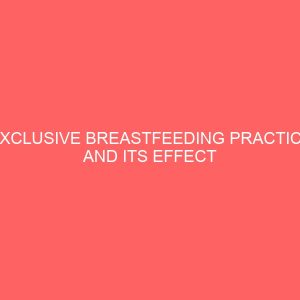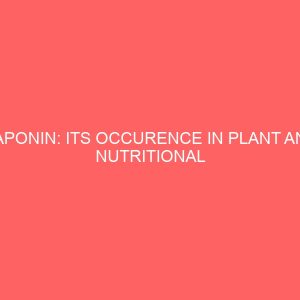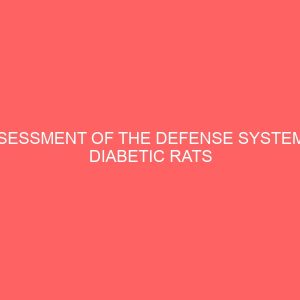Description
ABSTRACT
The study determined the availability, access and utilization of information communication technologies among staff of women in agriculture sub-programme of agricultural development programmes in north central zone of Nigeria. Four states were randomly selected which include Benue, Kogi and Nassarawa states, and the Federal Capital Territory. The multi-stage sampling procedure was used to select a sample size of eighty (80) WIA staff. Interview schedule was used to collect data from the respondents. Frequency count, percentage and mean score were used to analyze the data collected. Factor analysis with principal factor model with interaction and varimax rotation was used to determine the major constrains to the use of ICTs. The result of the study showed the mean age of the respondents to be 47.25 years with average working experience of 20.66 years and 14years as WIA staff. All (100%) the respondents were aware of radio, video machine, television and telephone and majority of them were aware of the other modern ICTs except for fax machine, GIS, Skype, face book and digital camera. Only a few (40% for telephone and 33.8% for radio) of them had ICT tools in their offices but majority (92.5% for radio and 88.8% for television) of them had personal ICTs. Majority (87.0%, 85.0% and 80.0%) of the WIA staff had access to telephone, television and radio respectively but very few (32.5% for computer 28.8% for internet and 8.8% for printer) of them had access to the modern ICT facilities. Majority (89.5%) of the few that accessed the internet did so for browsing to get information. The findings also showed that radio (M=3.70), Video machine (M=3.58), television (M=3.14) and telephone (M=3.49) were used by the respondents to a large extent. Majority (56.2% used radio for root and tuber processing and 62.5% used telephone for Fruit and vegetable processing) of them staff used a few ICTs for their WIA activities. Radio (M=3.06), television (M=2.88) and telephone (M=3.68) were perceived to be very important to the respondents in their official duties. Also, lack of training opportunities (M=2.25), insufficient availability of ICT facilities (M=2.06) and lack of technical know-how (M= 2.05) were perceived by the respondents to be serious constraints to the use of ICTs.
1. Based on the major findings it was concluded that majority of the respondents were still within active years and could access and use available ICT facilities and that though majority of them were aware of the ICT facilities, majority of them could not affectively operate most of the modern ICTs except for radio, video machine, television and telephone and to some extent, computer. Majority of them did not use most of the ICTs for official functions because they were constrained by lack of training opportunity, insufficient availability of ICT facilities and lack of technical know- how among other constraints perceived by the respondents to be serious to the use of ICTs for their official functions. The study, among other things recommended setting up of projects that will enable WIA staff to have more access to ICT tools and establishment of functional ICT centres with departments for WIA in all the states which will create more awareness, better accessibility and higher usage of ICT tools by the WIA staff.
Background Information
The sustainable production of food is the first pillar of food security; and millions of women work as farmers, farm workers and natural resource managers. In doing so, they contribute to national agricultural output, maintenance of the environment and family food security (Onyemobi, 2000). According to Nnadozie and Ibe (2000), women play very significant roles in Nigeria agricultural production, processing and utilization. Agricultural extension personnel are very important in the development of agriculture. They utilize strategic vital agricultural information for the individual and general improvement of the farmers, homemakers and youths. This could be in the area of their farming techniques, family nutrition and health and community development. Agricultural extensionists serve as links between farmers and researchers (Agumagu, Adesope, Mathews- Njoku and Nwaogwugwu, 2008). Therefore, Nnadozie and Ibe (2000) were of the opinion that the integration of women in extension is essential for the achievement of some goals such as increased food production, food self-sufficiency and sustained reduction of poverty and malnutrition.
The involvement of women in agriculture has attracted greater attention in recent years. Over the past two or three decades, considerable research has been done on gender – related issues in Nigerian agriculture. This has had some impact on policy formulation and programming, including perhaps the creation of Women- in- Agriculture (WIA) units in several State and Federal Government Ministries of Agriculture and the Agricultural Development Programmes (ADPs) in Nigeria. It is however difficult to gauge how effective this has been, especially in terms of moving agriculture forward. (Adekanye,Otitolaiye and Opaluwa, 2009). According to Onyibe (2001), the Agricultural development programmes of the different States of the Federation have made important advances in incorporating gender in agricultural extension, by modifying the ADP system midstream to provide for women farmers through the creation of WIA programmes in the Department of Extension Services of the ADPs with a gender focus.







